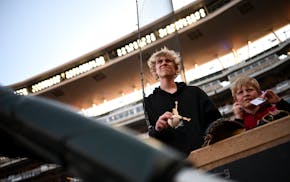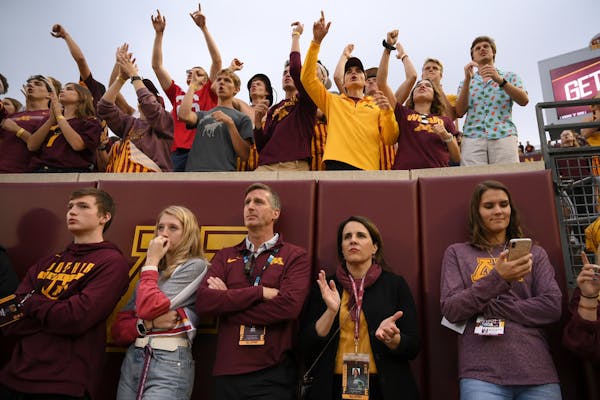With the Gophers athletic department facing $75 million in losses because of the coronavirus pandemic, three sports paid the ultimate price.
The Gophers announced Thursday they will no longer sponsor men's gymnastics, men's tennis and men's track and field (indoor and outdoor) — cutting their total from 25 programs to 21, pending Board of Regents approval after a presentation at Friday's meeting.
Athletic director Mark Coyle called it "a somber day" for his department. He spent 30 minutes on a video call with the 58 affected athletes, informing them the 2020-21 competition season — should the coronavirus not derail it — would be their last.
"Those young people have gone through a ton of uncertainty, just like each of us have. And they aren't easy conversations," Coyle said. " … We have special, special kids. And they're hurt. They're angry. They're confused. And I apologized to them. These are difficult, difficult decisions. And I really do feel for them."
Coyle said this decision was not only because of the COVID-19 financial strain but also for Title IX alignment. In the past three years, Coyle said, the female undergraduate population grew about 2-3%, so cutting the men's programs helps the athletics department mirror the student enrollment that is 54% female.
The pandemic, though, certainly forced the situation. When the Big Ten Conference postponed fall sports indefinitely on Aug. 11, it brought the Gophers' worst-case financial scenario to reality. Without ticket sales and media rights from football, college sports' biggest revenue-generator, the department faced a $75 million hit from a $130 million annual budget.
That budget is the eighth-biggest out of 14 Big Ten schools, but the Gophers had the fourth most sports programs in the conference, with 25.
Cutting sports will save the department an expected $2 million in fiscal year 2022, with an annual savings of $2.7 million once all the athletes in those sports have graduated. The Gophers said they will honor those existing athletics scholarships and allow affected athletes access to the same athletics services or help them transfer.
"I knew something like this might happen," said senior Shane Wiskus, the Gophers All-America gymnast. "I had a lot of hope, thinking maybe there was something they could come up with."
The Gophers also announced the elimination of eight athletic department jobs. That's in addition to the anticipated seven coaches cut with their sports were discontinued, so 15 positions have been severed. And several other open positions within the department have not been filled.
The athletic department will save an estimated $1.3 million through the school year from forced pay reductions and furloughs for employees across the department. In addition, Coyle and his top-five highest-paid head coaches — P.J. Fleck, Richard Pitino, Bob Motzko, Hugh McCutcheon and Lindsay Whalen — have taken 10% voluntary pay cuts, which will save an extra $1.2 million.
"We are doing everything we can," Coyle said, "to try to mitigate that lost revenue and manage our expenses to the best of our abilities."
The department had already reduced its 2021 budget by $5 million and instituted hiring and spending freezes. It has also had conversations with the U's central administration about a possible loan. Regent Michael Hsu said while he's sympathetic to the fact that the department is trying to save some money, cutting these sports, "doesn't really move the needle much."
Hsu also wished the athletic department had tried to raise funds to save those sports before cutting them, though an athletic department release stated there was no realistic fundraising amount that could accomplish that goal.
For Hsu, a solution to these financial issues is at hand if the Gophers play fall football.
"It's still possible," Hsu said. "It's a lot of money."
But Coyle wasn't sure if even football's potential return was enough to eradicate the economical downfalls.
"There's no question, football — it drives us financially," Coyle said. " … The uncertainty is what has been the biggest challenge with this pandemic so far. It's just, you don't know what it's going to look like when you can play.
"Can you have fans? What does the media revenue look like? What does the scholarship seating donations look like? What does the multimedia rights agreement look like?"
Coyle said the department hasn't had any more discussions of having to cut other sports. But the Gophers are not alone in their financial struggles or their solutions for it. For example, Iowa announced Aug. 21 it would cut men's gymnastics, men's tennis and men's and women's swimming and diving. The Hawkeyes anticipated losing $100 million in revenue, operating at a loss of $60-75 million this year.
"I hope each of us understand that these are people. They're students, they're coaches, they're staff," Coyle said. " … I can talk about numbers, I can talk about budget savings, we can talk about the revenue shortfall that we're facing, we can talk about Title IX, etc.
"But it's about people."
Staff writers Ryan Faircloth and Rachel Blount contributed to this article.
Webb Simpson offers to resign from PGA Tour board. But only if McIlroy replaces him, AP source says

Live: Twins vs. White Sox. Follow the action on Gameview
![Glen and Becky Taylor during game 1 on Saturday, April 20, 2024, at Target Center in Minneapolis, Minn. ] CARLOS GONZALEZ • carlos.gonzalez@startri](https://arc.stimg.co/startribunemedia/X74AVHP3ZBD4TPPPDJTNX5LN6M.jpg?h=91&w=145&fit=crop&bg=999&crop=faces)
Gameview: Wolves vs. Suns in Game 2. Up-to-the-second updates here.
Paris main airport unveils new baggage handling system ahead of the 2024 Olympics


